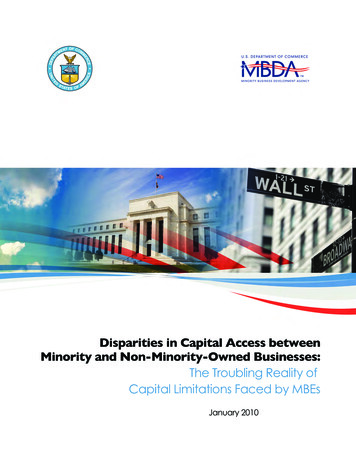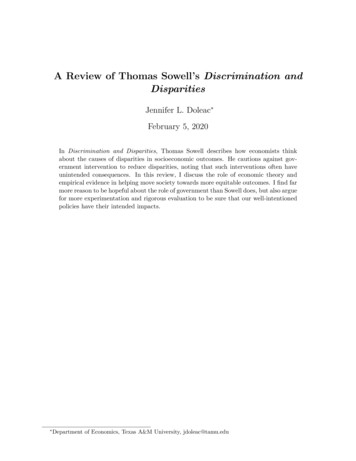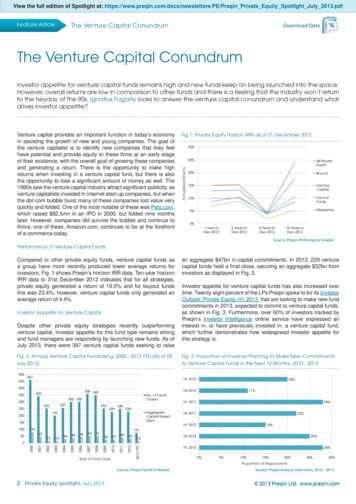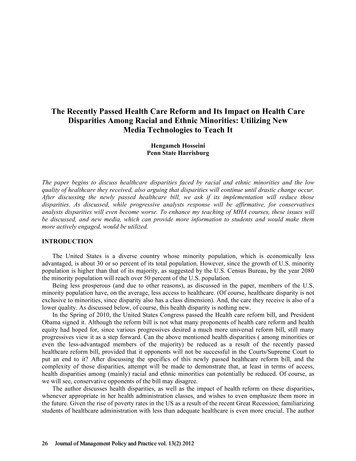
Transcription
Disparities in Capital Access betweenMinority and Non-Minority-Owned Businesses:The Troubling Reality ofCapital Limitations Faced by MBEsJanuary 2010
Disparities in Capital Access between Minority andNon-Minority-Owned Businesses:The Troubling Reality of Capital LimitationsFaced by MBEsU.S. Department of Commerce, Minority Business Development AgencybyRobert W. Fairlie, Ph. D. and Alicia M. Robb, Ph.D.January 2010This report was developed under a contract with the U.S. Department of Commerce’sMinority Business Development Agency, and contains information and analysis that wasreviewed and edited by officials of the Minority Business Development Agency.David HinsonNational DirectorMinority Business Development Agency
Table of ContentsPreface. 1Executive Summary. 3Introduction. 7The State of Minority Business. 9Total Gross Receipts of Minority-Owned Businesses. 10Total Employment and Payroll. 11Average Firm Performance. 13Previous Research on Constraints Faced by Minority-Owned Businesses. 17Financial Capital Constraints. 17Evidence of Lending Discrimination. 21Other Types of Discrimination. 22Human Capital Barriers. 22Family Business Background and Social Capital. 24The Current Financial Crisis. 27New Empirical Analysis. 31Data Description. 31Sources of Startup and Expansion Capital. 32Capital Use among More-Established Minority Firms. 35Regression Analysis of Equity Investment and Loan Amounts. 37Decomposition Estimates. 39Capital Use among Newly-Formed Minority Firms. 41The Employment Returns to Financing. 47Conclusions. 51Bibliography. 53About the Authors. 59
PrefaceCapital access remains the most important factor limiting the establishment, expansion and growthof minority-owned businesses. Given this well established constraint, the current financial environmenthas placed a greater burden on minority entrepreneurs who are trying to keep their businesses thriving intoday’s economy.In this study, Dr. Robert W. Fairlie and Dr. Alicia Robb provide an in-depth review and analysis ofthe barriers to capital access experienced by minority entrepreneurs, and the consequences that limitedfinancial sources are placing on expanding minority-owned firms.Minority-owned businesses have been growing in number of firms, gross receipts, and paidemployment, at a faster pace than non-minority firms. If it were not for the employment growth createdby minority firms, American firms, excluding publicly-held firms, would have experienced a greater jobloss between 1997 and 2002. While paid employment grew by 4 percent among minority-owned firms, itdeclined by 7 percent among non-minority firms during this period.Minority-owned businesses continue to be the engine of employment in emerging and minoritycommunities. Their business growth depends on a variety of capital, from seed funding to establish newfirms, to working capital and business loans to expand their businesses, to private equity for acquiring andmerging with other firms.Without adequate capital minority-owned firms will fail to realize their full potential. In 2002 there were4 million minority-owned firms, grossing 661 billion in receipts and employing 4.7 million workers. Ifminority-owned firms would have reached parity with the representation of minorities in the U.S. population,these firms would have employed over 16.1 million workers, grossed over 2.5 trillion in receipts, andnumbered 6.5 million firms. Increasing the flow of capital for minority-owned businesses must be a nationalpriority to re-energize the U.S. economy and increase competitiveness in the global marketplace.David A. HinsonNational DirectorMinority Business Development Agency1
Executive SummaryMinority business enterprises (MBEs) make a substantial contribution to the U.S. economy, generating 661 billion in total gross receipts in 2002. Minority-owned firms also employed 4.7 million people withan annual payroll totaling 115 billion. The growth rates in the total number of firms, employment andgross receipts of minority-owned businesses far outpaced non-minority-owned businesses between 1997and 2002. Had minority-owned businesses reached economic parity, the U.S. economy would haverecorded higher levels of key economic activity estimated at 2.5 trillion in gross receipts and 16.1 millionemployees. As defined by the Minority Business Development Agency, economic parity is achieved whenthe level of business activity of a business group is proportional to that group’s representation in the U.S.adult population.1Minority-owned firms are an engine of employment, with young firms creating jobs at similar ratesas young non-minority firms. Greater capital access for minority-owned firms is essential to sustain theirgrowth, reduce national unemployment levels, and in particular the high rate of unemployment in minoritycommunities.At the very time that broad economic productivity is critical to strengthening the economic foundationof the nation, the growth potential of minority-owned businesses is being severely hampered. Across thenation minority-owned businesses face the obstacles of access to capital, access to markets and access tosocial networks, all of which are essential for any business to increase in size and scale.A review of national and regional studies over several decades indicates that limited financial, human,and social capital as well as racial discrimination are primarily responsible for the disparities in minoritybusiness performance. Inadequate access to financial capital continues to be a particularly importantconstraint limiting the growth of minority-owned businesses. The latest nationally representative data onthe financing of minority firms indicates large disparities in access to financial capital. Minority-ownedbusinesses are found to pay higher interest rates on loans. They are also more likely to be denied credit,and are less likely to apply for loans because they fear their applications will be denied. Further, minorityowned firms are found to have less than half the average amount of recent equity investments and loansthan non-minority firms even among firms with 500,000 or more in annual gross receipts, and also investsubstantially less capital at startup and in the first few years of existence than non-minority firms.The current economic crisis is posing severe challenges for minority businesses to meet their potentialof creating 16.1 million jobs and generating 2.5 trillion in annual gross receipts. Existing obstacles togreater minority business success challenge the realization of the American Dream of ownership andwealth creation. Unless immediate action is taken, minority communities will continue to lag behind theirnon-minority counterparts undermining the ability of the nation to quickly regain its economic footing.U.S. Department of Commerce, Minority Business Development Agency, The State of Minority Business Enterprises, An Overview of the 2002Survey of Business Owners, Number of Firms, Gross Receipts, and Paid Employees (2006).13
Key FindingsJob Creation Young Minority-Owned Firms Create Jobs at Similar Rates as Young Non-Minority Firms Young minority firms created jobs at similar rates as young non-minority firms over the first fouryears of operations. Between 2004 and 2007, young minority firms created 3.1 jobs while youngnon-minority firms created 2.4 jobs during the same period according to an analysis of theKauffman Foundation Survey. Minority Businesses Create Jobs with Good Pay - The average payroll per employee wasnot substantially higher among non-minority employer firms compared to that of minority-ownedfirms. In 2002, payroll per employee was 29,842 for non-minority employer firms compared toabout 26,000 for minority-owned firms, according to data from the U.S. Census Bureau.Minority-owned firms are employing workers at similar wages as non-minority firms, and are thebackbone of many minority communities across the nation. 2001 U.S. Recession Benefited from Minority Business Job Creation - Between 1997 and2002, total employment declined by 7 percent among non-minority firms, however totalemployment increased among minority firms during the same period. Total employment grew by11 percent among Hispanic owned firms, by 5 percent among African American owned firms,and by 2 percent among Asian firms. For all minority firms employment increased by 4 percentduring the same period. If not for employment growth among minority-owned firms over thisperiod the loss in total employment would have been even larger: an additional 160,000 jobswould have been lost.Faster Growth4 Minority-Owned Firms Outpace Growth of Non-Minority Firms - Between 1997 and 2002,minority-owned firms far outpaced non-minority firms in terms of growth in number of businessestotal gross receipts, number of employees, and total annual payroll. Minority firms grew innumber of firms by 30 percent and in gross receipts by 12 percent, compared with an increaseof 6 percent in number of firms and 4 percent in gross receipts for non-minority firms. Totalemployment grew by 4 percent and annual payroll by 21 percent for minority-owned firmscompared to a decline of 7 percent in total employment and an increase in annual payroll of 8percent for non-minority firms during the same period. Minority-Owned Firms Lag Behind in Size Compared with Non-Minority Firms - Althoughminority-owned firms outpaced the growth of non-minority firms in several business measures,minority-owned firms are smaller on average than non-minority firms in size of gross receipts,employment, and payrolls. In 2002, average gross receipts of minority-owned firms were about 167,000 compared to 439,000 for non-minority firms. Average employment size of minorityemployer firms was 7.4 employees compared to 11.2 employees for non-minority employer firmsin 2002. Average payroll of minority employer firms was about 200,000 compared to 333,000for non-minority employer firms.
Capital Access DisparitiesLoans Minority-Owned Firms Are Less Likely To Receive Loans than Non-Minority Firms - Amongfirms with gross receipts under 500,000, 23 percent of non-minority firms received loanscompared to 17 percent of minority firms. Among high sales firms (firms with annual grossreceipts of 500,000 or more), 52 percent of non-minority firms received loans compared with 41percent of minority firms according to 2003 data from the Survey of Small Business Finances. Minority-Owned Firms Receive Lower Loan Amounts than Non-Minority Firms - Theaverage loan amount for all high sales minority firms was 149,000. The non-minority averagewas more than twice this amount at 310,000. Conditioning on the percentage of firmsreceiving loans, the average loan received by high sales minority firms was 363,000 comparedwith 592,000 for non-minority firms. Minority-Owned Firms Are More Likely To Be Denied Loans - Among firms with gross receipts under 500,000, loan denial rates for minority firms were about three times higher, at 42percent, compared to those of non-minority-owned firms, 16 percent. For high sales firms, therate of loan denial was almost twice as high for minority firms as for non-minority firms. Minority-Owned Firms Are More Likely To Not Apply for Loans Due to Rejection Fears Among firms with gross receipts under 500,000, 33 percent of minority firms did not apply forloans because of fear of rejection compared to 17 percent of non-minority firms. For high salesfirms, 19 percent of minority firms did not apply for loans because of a fear of rejectioncompared to 12 percent of non-minority firms. Minority-Owned Firms Pay Higher Interest Rates on Business Loans - For all firms,minority firms paid 7.8 percent on average for loans compared with 6.4 percent for non-minorityfirms. The difference was smaller, but still existed between minority and non-minority high salesfirms.Equity Minority-Owned Firms Receive Smaller Equity Investments than Non-Minority Firms - Theaverage amount of new equity investments was 3,379 for minority firms, which is 43 percent ofthe non-minority level. The average amount of new equity investments was 7,274 for minorityfirms with high sales, which was only 38 percent of the non-minority level according to 2003 datafrom the Survey of Small Business Finances. Venture Capital Funds Focused on Minority-Owned Firm Investments Are Competitive Venture capital funds focused on investing in minority-owned firms provide returns that arecomparable to mainstream venture capital firms. Funds investing in minority businesses mayprovide attractive returns because the market is underserved.5
Financial Investment6 Minority-Owned Firms Have Lower Loan and Equity Investments - Investment disparitiesbetween minority and non-minority firms were larger for external debt (bank loans, credit cards)and especially external equity, compared to the disparity in personal or family loan investments.Minority firms averaged 29,879 in external debt compared with 36,777 for non-minority firms.Minority firms had the most trouble obtaining external equity with 2,984 on average comparedwith 7,607 on average for non-minority firms. Disparities in Access to Financial Capital Grow after First Year of Operations - Non-minoritybusinesses invested an average of 45,000 annually into their firms, while minority-owned firmsinvested less than 30,000 on average after the first year of operation. The disparity in financialcapital between minority and non-minority firms was much larger in percentage terms for thenext three years in operation than their first year. Lower Wealth Levels Are A Barrier to Entry for Minority Entrepreneurs - Estimates fromthe U.S. Census Bureau indicate that half of all Hispanic families have less than 7,950 inwealth, and half of all African American families less than 5,446. Wealth levels among whitesare 11 to 16 times higher. Low levels of wealth and liquidity constraints create a substantialbarrier to entry for minority entrepreneurs because the owner’s wealth can be invested directlyin the business, used as collateral to obtain business loans or used to acquire other businesses. Experience, Geographic Location, Lower Sales and Industry Sectors Partially Limit CapitalAccess for Minority Firms - Minority-owned businesses had less business experience, lowersales, and less favorable geographical and industry distributions, all of which partially limitedtheir ability to raise financial capital.
IntroductionMinority businesses enterprises (MBEs) contribute substantially to the U.S. economy. Businessesowned by minorities produced 661 billion in gross receipts in 2002, and their growth rate in total grossreceipts far outpaced the growth rate for non-minority-owned businesses between 1997 and 2002.2 In2002, minority firms employed a workforce of 4.7 million people with an annual payroll of 115 billion.These jobs are located across the nation, many in emerging communities and employing a large proportionof minorities.3 Another contribution that is often overlooked, however, is that minority business ownerscreate an additional four million jobs for themselves.Although minority-owned businesses contribute greatly to the macro-economy and many areextremely successful, there remains a sizeable untapped potential among this group of firms. If minorityowned firms would have reached economic parity in 2002, these firms would have employed over16.1 million workers and grossed over 2.5 trillion in receipts.4 As defined by the Minority BusinessDevelopment Agency, economic parity is achieved when the level of business activity of a business group isproportional to that group’s representation in the U.S. adult population.5Minority-owned firms are smaller on average than non-minority-owned firms with lower gross receipts,survival rates, employment, and payrolls.6 The disparities are extremely large: for example, Hispanicowned firms have an average annual gross receipts level that is one-third the non-minority level, andAfrican American owned firms have an average annual gross receipts level that is one-sixth the nonminority level. A growing number of studies indicate that limited financial, human and social capital, as wellas racial discrimination are responsible for these disparities in business performance.7 Inadequate accessto financial capital is found to be a particularly important constraint limiting the growth of minority-ownedbusinesses.Given the current financial crisis, the credit markets have tightened and access to capital has beingfurther restricted for MBEs. Moreover, the rapid decline in the housing, stock and labor markets in the pastseveral months has taken a toll on an entrepreneur’s personal and family wealth. This wealth is importantbecause is frequently the primary source of capital entrepreneurs have for investing in their businesses.Likewise, the potential to receive outside equity funding from venture capitalists and angel investors hasalso dropped considerably in recent months. For example, the total amount invested by venture capitalistsplummeted from 5.7 billion for 866 deals in the fourth quarter of 2007 to only 3.0 billion for 549 deals inthe fourth quarter of 2008.82Robert Fairlie and Alicia Robb, Race and Entrepreneurial Success: Black-, Asian-, and White-Owned Businesses in the United States(Cambridge: MIT Press, 2008). U.S. Department of Commerce, Minority Business Development Agency, The State of Minority Business (factsheet), 2008 (accessed July 2009); available from http://www.mbda.gov/index.php?section id 6&bucket id 789#bucket 852.3Thomas D. Boston, The ING Gazelle Index, Third Quarter, 2003 (accessed July 2009); available from www.inggazelleindex.com. ThomasD. Boston, “The Role of Black-Owned Businesses in Black Community Development,” in Jobs and Economic Development in MinorityCommunities: Realities, Challenges, and Innovation, eds. Paul Ong and Anastasia Loukaitou-Sideris (Philadelphia: Temple University Press, 2006).U.S. Census Bureau, 1992 Economic Census: Characteristics of Business Owners (Washington, D.C.: U.S. Government Printing Office, 1997).4U.S. Department of Commerce, Minority Business Development Agency, The State of Minority Business Enterprises, An Overview of the 2002Survey of Business Owners, Number of Firms, Gross Receipts, and Paid Employees.5Ibid. Note: In 2002, minorities represented 29 percent of the U.S. adult population.6U.S. Census Bureau, 1992 Economic Census: Characteristics of Business Owners (1997). U.S. Census Bureau, 2002 Economic Census, Surveyof Business Owners (Washington, D.C.: US Government Printing Office, 2006).7U.S. Department of Commerce, Economics and Statistics Administration and the Minority Business Development Agency, Keys to MinorityEntrepreneurial Success: Capital, Education and Technology, Patricia Buckley (2002). David G. Blanchflower, P. Levine, and D. Zimmerman,“Discrimination in the Small Business Credit Market,” Review of Economics and Statistics 85, no. 4 (2003): 930-943. Ken Cavalluzzo, LindaCavalluzzo, and John Wolken, “Competition, Small Business Financing, and Discrimination: Evidence from a New Survey,” Journal of Business75, no. 4 (2002): 641-679. Fairlie and Robb, Race and Entrepreneurial Success: Black-, Asian-, and White-Owned Businesses in the United States.8PricewaterhouseCoopers and the National Venture Capital Association, MoneyTree Report, 2009 (accessed October 2009); available fromhttp://www.pwcmoneytree.com.7
Banks and other lending institutions have also severely tightened lending standards and increasedloan costs to small, medium and large businesses. In its annual survey of senior loan officers, the FederalReserve found that 65 percent of domestic banks have “tightened lending standards on commercialand industrial loans to large and middle-market firms,” and 70 percent of these banks tightened lendingstandards to small firms. In addition, “large fractions of banks reported having increased the costs ofcredit lines to firms of all size.”9 Banks are reluctant to lend to minority-owned firms and other businessesin the current economic recession because of concerns about the ability to repay loans. Additionally, thedecline in the personal wealth of entrepreneurs has limited their ability to use this wealth as collateral orpersonal guarantees for loans. The secondary market for loans has dried up, and many banks, especiallycommunity banks, are struggling to have enough deposits to meet the demand for loans.Diminishing credit access and higher borrowing costs will disproportionately impact the creation andgrowth of minority businesses across America. The recent unprecedented decline in the financial marketcombined with a severe drop in demand for goods and services resulting from the current economicrecession may lead to many minority business failures. Anecdotally, business trade organizations and theMinority Business Enterprise Centers funded by the Minority Business Development Agency have reportedthat credit lines of viable minority-owned businesses have been closed down by their lending institutions.As a result of the existing financial constraints, the tremendous growth in number of firms, gross receiptsand employment enjoyed by minority firms during the past decades could be halted with large negativeconsequences for the entire U.S. economy.It is an important policy concern to ensure and ultimately improve the performance of MBEs in theUnited States. Business owners represent roughly 10 percent of the workforce, but hold nearly 40 percentof the total U.S. wealth.10 Strong minority business growth directly impacts the reduction of inequality inearnings and wealth between minorities and non-minorities.11Another concern is the loss in economic efficiency resulting from blocked opportunities forminorities to start, acquire and grow businesses. Among these barriers to business formation areliquidity constraints and unfair lending practices that result from structural inequalities or racialdiscrimination. Barriers to entry and expansion faced by MBEs are very costly to U.S. productivity,especially as minorities represent an increasing share of the total population. Additionally, by limitingthe business success to only a few groups and not the broad range of diverse groups that comprisethe United States we are constraining innovative ideas for new products and services, and access toglobal markets where many minority entrepreneurs have a competitive advantage based on culturalknowledge, social and familial ties, and language capabilities.12In addition, barriers to business growth may be especially damaging for job creation in emergingcommunities.13 Minority firms in the United States employed nearly 4.7 million paid workers in 2002,14 adisproportionate share of them minorities and many of these jobs are located in minority and emergingcommunities. Without the continuing success and expansion of minority businesses the benefits of economicgrowth will be unevenly divided across the population.Board of Governors of the Federal Reserve System, The January 2009 Senior Loan Officer Opinion Survey on Bank Lending Practices, 2009(accessed July 2009); available from ey/200902/default.htm.10Board of Governors of the Federal Reserve System, “Recent Changes in U.S. Family Finances: Evidence from the 2001 and 2004 Surveyof Consumer Finances,” Federal Reserve Bulletin, Brian K. Bucks, Arthur B. Kennickell, and Kevin B. Moore, 2006 (accessed October 2009);available from 206.pdf.11William D. Bradford, “The Wealth Dynamics of Entrepreneurship for Black and White Families in the U.S.,” Review of Income and Wealth 49 (2003): 89-116.12John Owens and Robert Pazornik, Minority Business Enterprises in the Global Economy: The Business Case. Prepared in collaboration with theMinority Business Development Agency (Washington D.C.: Minority Business Development Agency, 2003).13Thomas D. Boston, “Generating Jobs through African American Business Development,” Readings in Black Political Economy, eds. J.Whitehead and C. Harris (Dubuque: Kendall-Hunt, 1999). Boston, “The Role of Black-Owned Businesses in Black Community Development.”14U.S. Census Bureau, 1992 Economic Census: Characteristics of Business Owners. U.S. Census Bureau, 2002 Economic Census: Survey of Business Owners.98
The State of Minority BusinessTo gain some perspective on the state of minority business in the United States we briefly discusscurrent business ownership and performance patterns. We first discuss estimates of minority businessownership created from microdata from the 2008 Current Population Survey (CPS). This survey isconducted by the U.S. Bureau of Labor Statistics and Census Bureau and contains the latest availablenational data on business ownership in the United States. Table 1 reports the business ownership rate,which is the ratio of the number of business owners to the total workforce. The CPS captures individualswho own all types of businesses including incorporated, unincorporated, employer and non-employerbusinesses although owners of side- and low-hours businesses are excluded.15Table 1Business Ownership Rates by Race/EthnicityCurrent Population Survey (2008)Business OwnershipPercent ofWorkforceSample e-American7.6%6,570Asian/Pacific can5.5%61,957Notes: (1) The sample consists of individuals ages 20-64 whowork 15 or more hours per usual week. (2) Business ownershipstatus is based on the worker's main job activity and includesowners of both unincorporated and incorporated businesses. (3)All estimates are calculated using sample weights provided bythe Current Population Survey.In the United States, 10.1 percent of the total workforce owns a business. Business ownership rates,however, differ substantially by race and ethnicity. Despite the growth in the number of minority firmsbetween 1997 and 2002, minority business ownership rates as a percentage of the minority workforcelagged behind those of non-minorities. Business ownership rates are the highest for non-minorities (i.e.non-Hispanic whites) at 11.3 percent. Asians have the next highest rate at 10.3 percent, which is similar tofindings in previous studies.16 There are differences across Asian groups, however, with some groups suchas immigrants from the Philippines having very low rates of business ownership.Owners of side- and small-scale businesses are excluded because business ownership status is defined for the main job activity and onlyworkers with at least 15 hours worked in the survey week are included in the sample. Published estimates from the CPS only includeunincorporated business owners and do not restrict the number of hours worked.16Kwang Kim, Won Hurh, and Maryilyn Fernandez, “Intragroup Differences in Business Participation: Three Asian Immigrant Groups,”International Migration Review 23, no. 1 (1989). Don Mar, “Individual Characteristics vs. City Structural Characteristics: Explaining SelfEmployment Differences among Chinese, Japanese, and Filipi
January 2010 This report was developed under a contract with the U.S. Department of Commerce's Minority Business Development Agency, and contains information and analysis that was . Capital access remains the most important factor limiting the establishment, expansion and growth of minority-owned businesses. Given this well established .










